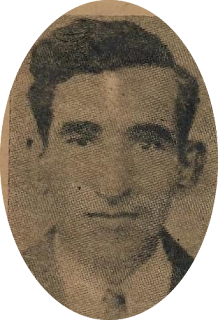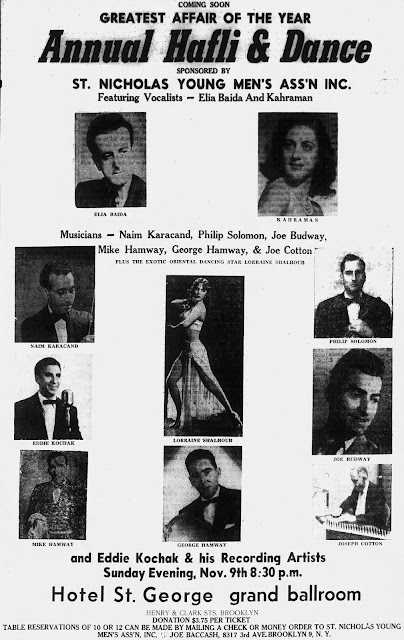Mike Hamway: Syrian American Derbakist Extraodinaire
Mike Hamway: Syrian American Derbakist Extraodinaire
 |
| Mike Hamway, Derbake Player. Courtesy of Richard M. Breaux collection. |
Usually in Arabic music ensembles, a lead singer, oudist, or violinist gets the majority of attention or have the opportunity to showcase their talents in an oud or violin taqsim. Derbake (dirbakeh, darbuka) players or drum players hardly ever warrant attention, but this month’s post changes all that. One of the most sought after, East Coast derbake players of the middle period was older than many of the other musicians with whom he performed. This fact also helps us understand his passing in the 1960s as the nightclub era was in its infancy. This derbake player is best known for performing with Anton Abdelahad, Joe Budway, Philip Solomon, and Russell Bunai. We’re talking about, of course – Mike Hamway.
Mike Hamway was born Michayel Hamway 7 November 1892 in Aleppo, Syria. It’s unclear how many siblings he had or who taught him to play the derbake, but Hamway immigrated to the United States in 1915 via Montreal, Canada. Fortunately for Hamway, George Dow’s court case cleared the path for Syrian immigrants to gain naturalized U.S. citizenship. When Hamway arrived in Canada, and later in the United States, he listed his occupation as a Silk Weaver. Where Hamway initially settled remains a mystery, but it may have been in Summit, New Jersey. We also don’t know whether he managed to play on any Victor or Columbia sides in the 1910s or Maloof and Macksoud records in the 1920s. According to family members, he played the derbake professionally for 56 years, which means he played since he was sixteen in 1908 – at least seven years before immigrating to the United States.
Nineteen hundred sixteen saw Michayel wed fellow Syrian, Mary Asbaty; their first child, Charlie, was born within a few years’ time, in December, 1918, in New Jersey. The climate and attitude towards Syrian immigrants, and immigrants in general, changed significantly between the birthdates of the Hamway children, as nativist sentiments took hold of segments of the U.S. population. Mary and Mike had a second son, George, around 7 June 1927 in Passaic. When they could, the family attended Saint Ann’s Catholic Church in Paterson. Mike actively participated in the local Aleppo Charity Society.
 |
| Mike Hamway's immigration Petition for Naturalization. Courtesy of Ancestry.com |
The 1930s witnessed the decline in 78 RPM record production and Arab American record labels like Maloof and Macksoud were not spared; some musicians, however, were beginning to be able to earn a living solely as professional musicians. The 1930 U.S. Census lists Mike Hamway as a musician in a band, but both the 1940 Census and his World War II draft card curiously note that Hamway was unemployed. These documents are all the more curious because, at least, from 1931 on, Hamway's name appears regularly in the press as an active percussionist. One such instance in May, 1931, was at a Syrian Women’s Club arts and crafts exhibition fundraiser in New Jersey where Hamway played derbake in an all-Syrian orchestra that included Kareem Maroon on oud, Alexander Fatti on violin, Joseph Shennaky also on violin, Mike Dakkak on tambourine or riqq, and Albert Kasala on ney. Just over one year later, he, former Columbia star Moses Cohen, Naim Karacand, and Fathallah Abaid rocked a crowd of an estimated 5,000 for the Passaic County Syrian American League. Violinist Philip Solomon, Fathallah Abaid, Abraham Dwek, Mosa Kalooky, and Hamway performed at the fifteenth annual two-day Saint Anne’s Mahrajan in August 1937. By December 1938, Hamway, this time on riqq, teamed up with Anton Abdelahad, Russell Bunai, Naim Karacand, Fathallah Abaid for a Knights of Saint George gala attended by some 400 Lebanese and Syrian Americans for a New Year’s Eve celebration. The following year in May and October, another 400 souls packed the venue to hear Mike and Fathallah Abaid join 1920s Arab American recording star Mayer Murad.
 |
| Saint Nicholas Young Men's Association, 1958, The Caravan, 23 October. A host of Arab American musicians performed including Mike & George Hamway. Courtesy of Newspapers.com |
Private parties and celebrations, political events, birthdays and wedding receptions were as lucrative as the mahrajan circuit. In October 1940, Russell Bunai, Richard Eshack, Naim Karacand, Joe Budway, and Mike Hamway played the Salam Republican League banquet in Prassaic. A week later, Najeeba Morad, M.S. Hawie, Naim Karacand, Mike Hamway and others entertained community leaders including newspaper editors A. A. Haddad, of As-Sayed “The Roamer” and Nasib Arida of the “Daily Mirror” for the silver anniversary celebration of the Homsian Fraternity in New Jersey. The twenty-fifth anniversary of the Blossom of Damascus Christian Society in Paterson, New Jersey, brought Russell Bunai, Naim Karacand, Fathallah Abaid and Mike Hamway together again in 1941, just months after Mike and Mary’s son, George, wed earlier in the year. By the time the Japanese bombed Pearl Harbor, months later, Mike entered his 49th year exactly one month to the day the Brooklyn-built U.S.S. Arizona met its fiery demise.
The absence of news reports and newspaper articles between 1942 and 1944 with even a mere mention of Hamway suggests that he and other Syrian American musicians participated in the American Federation of Musicians Strike during this two-year period. Meanwhile, Farid Alam contracted with the federal government via the Department of Defense to Royalties for bands and backup musicians like Hamway remained at the heart of protests and negotiations related to the strike. This might explain why some pressings of Abdelahad only mentioned led oudist and singer Anton Abdelahad only, but other pressings also list Philip Solomon on violin and Mike Hamway on derbake.
 |
| Front: Philip Solomon, Joe Budway, Mike Hamway. Rear: Anton Abdelahad, Russell Bunai. Courtesy of Anthony A. |
Mike Hamway’s career reached new heights in the 1940s and 1950s and, without question, his peers considered him one of the best and most skilled derbake players of their generation. Whether it was gigs such as the Syrian American Democratic Club of Paterson banquet alongside Naim Karacand and Charles Abaid, in October 1945, the Syrian American Republican Club “Arabian Nights program” in October 1947, private parties for Arab American soldiers returning from World War II, testimonial recognitions of Arab American elders who dedicated their lives to charity work or civic causes, graduation parties, or disaster relief haflas, concerts, or multi-day mahrajans, there were few events where Mike Hamway was not a part of the ensemble that backed some of the biggest singers in Arab America – Hanan, Eddie Kochak, Najeeba Morad, Amer & Sana Kadaj, Elia Baida, Kahraman, Lila Stephans, Odette Kaddo, or Fadwa Abeid.
When Tony Abdelahad founded his own record label in the mid-1940s to the early 1950s, Philip Solomon and Mike Hamway accompanied Abdelahad as a part of his regular ensemble. On at least one occasion, for the single "Il Nylon," KGS 7001A-B, Hamway's name appears along with Adbelahad and Solomon in an instance that became more common on some 78 RPM labels in the 1940s. Interestingly, only Abdelahad's name appeared on label variations for the same song. Abdelahad label variations included white print on a red label, dark blue ink on a sky-blue label, and red and blue ink on a white label. The other unique characteristic of Abdelahad's white, red, and blue label is that no Arabic script appears on this label variant.
 |
| A star-studded night Labor Day Weekend: The Lebanon of America, Caravan 21 August 1958. Courtesy of Newspapers.com |
The hafla and mahrajan circuit in the 1950s kept Hamway busy, as did recording opportunities throughout the decade. In May 1951, one of the hottest, most sought-after tickets of the year was the concert at the John Raad American Legion Post. Najeeba Morad, Tony Abdelahad, Joe Budway, Philip Solomon, Mohamed El-Bakkar all headlined at the event. The annual outing sponsored by Saint Anne Church's featured the same lineup a few weeks later. The Saint Elias SOYO, in August of 1951, mixed things up a bit when Hamway, Naim Karacand, Joe Budway backed Sana and Amer Kadaj. Paterson's Aleppian Society booked Hamway to play with Elia Baida, Naim Karacand, and and Fathella Abayed, in June 1952. Sometime, as was the case in August 1953, Sana and Amer Kadaj, fronted Naim Karacand, Mike Hamway, and Armenian American oudist John Nazarian. Hamway continued on the hafla-mahrajan circuit from 1953 to 1956 jamming with Arab American and Middle Eastern ensembles at the annual Saint Nicholas event starring Elia Baida, Odette Kaddo or at Brooklyn's Aleppian Foundation starring Hanan and Leila Stephans. A busy Mike Hamway worked an exhaustively packed schedule in 1957 and 1958; in fact, Hamway performed at seven separate events between June 28 to September 20, 1958. Demonstrating his versatility and expertise as a derbake player who could hold his own with any musician, Mike Hamway appeared on Ahmed Abdul Malik’s 1958 album Jazz Sahara. This four-song-experimental Arabic jazz fusion record recorded by former Thelonious Monk bassist included Arab American musicians, violinist Naim Karakand, kanoon player Jack Ghanaim, and Mike Hamway on derbake. Less than two years later, in 1959, Ahmed Abdul Malik invited Mike Hamway, Naim Karacand, and few other musicians back to record his album East Meets West. This much more musically ambitious project had an ensemble almost twice as big as Jazz Sahara.
 |
| Celebration in Honor of Mike Hamway, The Caravan 16 April 1959. Courtesy of Newspapers.com |
In April of 1959, Mike Hamway’s friends and family gathered in Paterson at Saint Anne’s Hall on Marshall Street to celebrate his storied musical career. Since he immigrated to the United States, Hamway had recorded some 250 songs and had played with almost every popular Arab American singer from Nahum Simon and Russell Bunai to Amer and Sana Kadaj, Najeeba Morad, and Hanan.
| Mike Hamway performed on "Il Nylon" along with Anton Abdelahad, and Philip Solomon. Courtesy of Richard M. Breaux collection. |
Somethings changed, while others stayed the same, as Mike Hamway’s career entered a new decade. On September 11, 1960, he, Anton Abdelahad, Naim Karacand, and Mike’s son George played at the Aleppian Charity Society’s scholarship fund banquet in Caldwell, New Jersey. Hamway played several gigs on the regular New York and New Jersey hafla circuit in 1961 and 1962, but most of his regular performances were limited to events sponsored by Saint Ann’s or the Aleppian Charity Society. When the Charity Society hosted its 40th anniversary in October 1962, special guest singer Hanan joined the Abdelahad quartet which made this an especially memorable celebration. In the spring of 1963, however, Mary Asbaty Hamway died at the age of 67. Mike was devastated. Although comforted by their two sons, three grandchildren, the presence of a brother-in-law who also lived in Paterson, life just wasn’t the same without Mary. Paterson’s John Raad Post #430 hosted its annual hafla in October 1963, and the all-too familiar quartet of Abdelahad, Karacand and the Hamways showed why they were considered some of the best musicians in the business. This was one of Mike Hamway’s last publicized performances.
On 1 August 1965, Michael Hamway died at Saint Joseph’s Hospital in Paterson. He was 72. What is perhaps most ironic and curious to anyone researching Mike Hamway’s career and life is that another Michael Hamway from Syria, who lived in Summit, New Jersey, but was seven years older than the derbake player Mike Hamway, died in June 1965. George Hamway, percussionist and the youngest son of Mary and Mike Hamway, continued on as a musician into the 1990s and died in 2000.
 |
| George Hamway, Mike Hamway's son, played tambourine. Caravan 24 September 1959. Courtesy of Newspapers.com |
Special thanks to Anthony Abdelahad for use of his photographs.
Richard M. Breaux
© Midwest Mahjar












Comments
Post a Comment